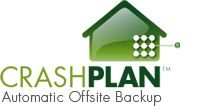Yesterday, I posted my experiences with Carbonite and Mozy and explained why they’re not a good option for someone who wants an inexpensive, truly unlimited and fast backup solution. Today, I’m going to explain the solution I found with CrashPlan.
CrashPlan is a direct competitor to Carbonite, Mozy and Backblaze. However, the wonder of CrashPlan is that they separate their software from their service.
CrashPlan Plus is the service. For $5 per month, users can upload an unlimited amount of personal data. The low cost alone sets it ahead of Mozy and Carbonite.
The CrashPlan software, however, has the ability to backup not only locally but also to a friend. The CrashPlan software can be freely downloaded and used without a subscription.
Controls are very easy to understand and use. CrashPlan assumes you want to backup the data in your home directory. You can easily adjust that setting and specifically include or exclude individual folders or files. You can limit the upload and download speeds based on time of day or if you’re present or away from your computer.
Let’s look at an example use case. A large amount of data exists on a file server at the office. I want to automatically backup that data locally and off site. I purchase a Drobo and a large external USB drive. I configure the Drobo at the office and connect it to the file server. I take the large external drive home and connect it to my home PC. I install CrashPlan on the file server and on my home PC, telling the file server to backup friends’ data to the Drobo and the home PC to back up friends’ data to the external hard drive.
I configure CrashPlan on the file server to back up all the data stored on the server to the Drobo connected to it. This action creates a second copy of my data that is stored locally on a different type of media – I’m making the case that storing the data on a Drobo with its drive redundancy is different from storing it on a single drive. I tell it to also back up the data to a friend. It prompts for the friend’s authorization code and I give it the code from my computer at home. It instantly begins copying the data to both the Drobo and over the Internet to the USB drive at home.
On the home computer, I tell it to back up to a friend and provide the code from the computer at the office. It begins backing up any files from home to the Drobo. If I stored important information at home, I could easily tell it to also backup to the external drive in addition to the Drobo to satisfy the 3-2-1 practice for my data at home.
I could also configure Crashplan for my laptops and coworkers by simply giving them the code to bakup to the Drobo. It’s remarkably easy, and only the user can restore the data. The security theoretically makes it safe to back up to a stranger, since you’re only storing encrypted data on the other machine.
I recently had the opportunity to test this configuration. In my configuration, I have my parents’ computer set to back up to my media center. When their computer crashed and they purchased a replacement, I plugged the replacement directly into the Drobo, installed Crashplan and began the restoration process directly, saving the time of having to download the restore files. A huge advantage to CrashPlan is that it can recognize the data storage location both locally and remotely. The initial backup can be done locally and then the drive can be moved to a computer off site.
I’m much more fond of this backup solution than using a commercial service. While the initial cost of the Drobo and the hard drive seems high, factoring in the cost of paying for backup subsriptions to several PCs and laptops each month as well as the enormous expense in the event of a crash makes this solution much more economically desirable in my mind. Remaining in control of the physical backup destination may be more responsibility, but if something bad every happens the solution is to simply retrieve the backup sets from the off-site location, not spending months downloading or spending a ton of money. That piece of mind is priceless.
Have you found a better solution or a problem with CrashPlan? Let me know in the comments.

